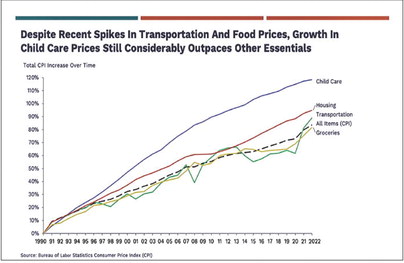County to revisit childcare shortage


By Kevin O’Brien
Later this month, the Marathon County Board will revisit a resolution calling for the possible deregulation of homebased daycares amid a childcare shortage that is keeping many parents out of the workforce.
At its Oct. 24 meeting, the board voted to essentially table a resolution from supervisor David Baker that rejects the idea of providing subsidies to childcare providers and families and recommends a review of what some believe are overly burdensome regulations. Action was delayed on the proposal after Dave Eckmann, president of the Wausau Region Chamber of Commerce, invited supervisors to a town hall discussion the following night featuring area business leaders struggling to recruit workers due to lack of affordable
See CHILDCARE QUANDARY/ page 2 Childcare quandary
Continued from page 1
childcare options.
A recording of the town hall shows Eckmann leading a 90-minute discussion about what he called a complex threat to economic development in Marathon County. In today’s highly competitive labor market, he said local employers are at a disadvantage if the area can’t deliver reliable childcare options.
“If we’re not attracting and retaining talent and we’re not growing, companies are going to go elsewhere,” he said.
Micki Krueger, assistant director of Childcaring, Inc. referral center in Mosinee, shared the story of a traveling nurse who was looking to accept a job at Marshfield Clinic but needed childcare for her newborn baby. She said her agency contacted over 30 childcare providers in the Marshfield area, but none of them had an open slot available for the woman.
“She was unable to take the position and turned down the contract,” Krueger said.
Krueger was one of several panel members who presented a flurry of statistics and data charts showing a major decline in the number of licensed childcare providers in Marathon County, along with a decrease in open slots available for parents to enroll their kids in daycare.
According to information provided by Eckmann, the average cost of childcare in Central Wisconsin ranges from just over $10,000 per year for a school-age child up to $13,700 for an infant. For a family with two kids, he said the annual cost of childcare is far more than rent and mortgage payments, and it’s more expensive than the average tuition at a University of Wisconsin campus.
Eckmann also displayed a chart showing that childcare subsidies provided by the state are not keeping pace with the inflationary costs of daycare.
“This shows you, subsidies are not going to solve this problem,” he said.
For the past three years, since the start of the COVID-19 pandemic, the federal government has been providing millions of dollars in monthly payments to childcare providers to prevent them from laying off workers or closing. However, funding for the Child Care Counts program dropped by 50 percent in June of this year and is slated to run out completely in January. Gov. Tony Evers has allocated $170 million to keep the subsidies going at 50 percent until June of 2025, according to Kelly Borchardt, executive director of Childcaring, Inc.
“It has bought us more time for discussion and problem-solving,” she said.
Eckmann emphasized the need for public-private partnerships to address the problem and said many local businesses are thinking about providing childcare stipends for their employees or even investing in daycare facilities.
“Business and industry are ready to step up to the table,” he said.
Matt Orht, co-founder of Self Fund Health, shared his experience as former vice-president of HR and medical services for Merrill Steel in Schofield, which came very close to establishing its own daycare facilities for employees. Ohrt said the company was “five minutes away” from opening the center, having already purchased the space and hired staff, but a regulatory issue and an opportunity to rent out the space prevented that from happening.
Orht said the daycare space was on the second floor of a building, which required a special permit from the state to allow infants and toddlers to enroll. If he were still in his former position at Merrill Steel, Ohrt said he would still be trying to make the in-house daycare work, but that would require a solid cost-benefit analysis based on the number of children enrolling.
“Once you hit the break-even point, it opens up doors,” he said.
One audience member noted that Marathon County is largely rural, and many parents living in smaller communities would prefer to leave their children at local home-based daycares rather than bringing them to larger centers on their way to work.
Borchardt said family-run daycares are an “important piece of the puzzle,” but there’s been an “alarming trend” of those operations closing in recent years, often due to burnout.
“Family childcare is a really hard job,” she said. “You’re at home, 10 to 12 hours a day, with children by yourself. Then there’s all the business-end of childcare that you’re doing on the weekends.”
Although there is a lot of funding support available for family childcare providers, Borchardt acknowledged that her agency could be doing more to recruit those interested in starting homebased daycares.
When asked about the issue of regulation, Borchardt noted that there are six bills that have been passed by the Wisconsin Assembly and are currently being discussed in the State Senate. She said they deal with everything from staff-to-child ratios to whether or not 16-year-olds should be allowed to work as assistant childcare teachers. However, even if the bills were to be passed by the Senate, Borchardt predicted that Gov. Evers would veto them.
During her 30 years working in childcare, Borchardt said she has only seen state regulations changed three times at the end of a long, deliberative process. Although she has publicly opposed the county resolution supporting greater scrutiny of regulations, Borchardt said she is not against reviewing the rules on a regular basis.
“I think we should always be looking at regulation,” she said. “I think it’s an important thing to consider, but not at the cost of being harmful to children.”





